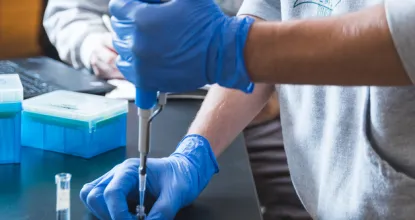Dr. Evan Pratt
Assistant Professor
Contact Information:
Office: 3322 WSTN
Phone: (906) 227-1088
Email: evpratt@nmu.edu
Bio:
BACKGROUND
Dr. Evan Pratt is a Tenure-Track Assistant Professor in the Department of Chemistry at
Northern Michigan University. Dr. Pratt graduated from Lyman Briggs College (Michigan State
University) in 2010 with a degree in Biochemistry and Molecular Biology. He had a phenomenal
experience as an undergraduate researcher in Dr. Susanne Hoffmann-Benning’s lab at MSU,
which steered him toward a career in teaching and research. He pursued his Ph.D. under the
direction of Dr. Gregory Hockerman in the Department of Medicinal Chemistry and Molecular
Pharmacology at Purdue University. As a graduate student at Purdue, he studied the interplay
of Ca 2+ , cAMP and ERK signaling in pancreatic β-cells using advanced fluorescence live-cell
imaging. After receiving his Ph.D. in 2017, Dr. Pratt trained under Dr. Amy Palmer in the
BioFrontiers Institute at the University of Colorado Boulder. His postdoctoral work was centered
on engineering genetically encoded fluorescent Zn 2+ sensors to further understand Zn 2+
biochemistry in living mammalian cells.
TEACHING
Since joining NMU in Fall 2020, Dr. Pratt has taught biochemistry courses in the department,
including CH 450: Biochemistry I, CH 452: Biochemistry II and CH 454: Biochemical
Techniques. He also has an active research program that involves the work of several talented
undergraduate students from chemistry and biology. If you are interested in joining the lab,
please contact Dr. Pratt by email.
RESEARCH
The overall goal of the Pratt Lab is to develop state-of-the-art fluorescent sensors of the metal
ion, Mg 2+ . Using an advanced fluorescence microscope, these tools will allow us to take a high-
resolution glimpse of Mg 2+ biochemistry in living mammalian cells. We are focused on
elucidating the subcellular distribution of Mg 2+ , determining how cellular Mg 2+ levels are
regulated and finally, teasing out the interplay between Mg 2+ dynamics and cellular metabolism.
In addition to our primary work on Mg 2+ sensor development, we are working on several
additional research projects in collaboration with other groups on campus. Please reach out to
hear more about this exciting work.
RECENT PUBLICATIONS
Pratt, E.P.S., Damon, L.J., Anson, K.J. & Palmer, A.E. (2021). Tools and techniques for
illuminating the cell biology of zinc. Biochim Biophys Acta Mol Cell Res. 1868(1), 118865.
https://doi.org/10.1016/j.bbamcr.2020.118865
Pratt, E.P.S., Anson, K.J., Tapper, J.K., Simpson, D.M. & Palmer, A.E. (2020). Systematic
Comparison of Vesicular Targeting Signals Leads to the Development of Genetically Encoded
Vesicular Fluorescent Zn 2+ and pH Sensors. ACS Sens. 5(12), 3879-3891.
https://doi.org/10.1021/acssensors.0c01231
Pratt, E.P.S., Harvey, K.E., Salyer, A.E. & Hockerman, G.H. (2019). Regulation of cAMP
accumulation and activity by distinct phosphodiesterase subtypes in INS-1 cells and human
pancreatic beta-cells. PLoS One. 14(8), e0215188.
https://doi.org/10.1371/journal.pone.0215188
Pratt, E.P.S., Owens, J.L., Hockerman. G.H. & Hu, C.D. (2016). Bimolecular Fluorescence
Complementation (BiFC) Analysis of Protein-Protein Interactions and Assessment of Subcellular Localization in Live Cells. Methods Mol Biol. 1474: 153-170. https://doi.org/10.1007/978-1-4939-6352-2_9
Pratt, E.P.S., Salyer, A.E., Guerra, M.L. & Hockerman, G.H. (2016). Ca 2+ influx through L-type
Ca 2+ channels and Ca 2+ -induced Ca 2+ release regulate cAMP accumulation and Epac1-
dependent ERK 1/2 activation in INS-1 cells. Mol Cell Endocrinol. 419, 60-71.
https://doi.org/10.1016/j.mce.2015.09.034

